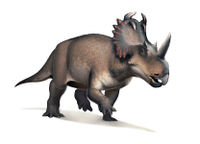Centrosaurus
Centrosaurus (/ˌsɛntroʊˈsɔːrəs/ SEN-troh-SOR-əs) is a genus of herbivorous ceratopsian dinosaurs from the Late Cretaceous of Canada. Their remains have been found in the Dinosaur Park Formation, dating from 76.5 to 75.5 million years ago.[1]
The first Centrosaurus remains were discovered and named by paleontologist Lawrence Lambe in strata along the Red Deer River in Alberta, Canada. The name Centrosaurus means "pointed lizard" (from Greek kentron, κέντρον, "point or prickle" and sauros, σαῦρος, "lizard"), and refers to the series of small hornlets placed along the margin of their frills, not to the nasal horns (which were unknown when the dinosaur was named). The genus is not to be confused with the stegosaur Kentrosaurus, the name of which is derived from the same Greek word.
Later, vast bonebeds of Centrosaurus were found in Dinosaur Provincial Park, also in Alberta. Some of these beds extend for hundreds of meters and contain thousands of individuals of all ages and all levels of completion. Scientists have speculated that the high density and number of individuals would be explained if they had perished while trying to cross a flooded river.[2] A discovery of thousands of Centrosaurus fossils near the town of Hilda, Alberta, is believed to be the largest bed of dinosaur bones ever discovered. The area is now known as the Hilda mega-bonebed.[3]
Because of the variation between species and even individual specimens of centrosaurines, there has been much debate over which genera and species are valid, particularly whether Centrosaurus and/or Monoclonius are valid genera, undiagnosable, or possibly members of the opposite sex. In 1996, Peter Dodson found enough variation between Centrosaurus, Styracosaurus, and Monoclonius to warrant separate genera, and that Styracosaurus resembled Centrosaurus more closely than either resembled Monoclonius.
Dodson believed one species of Monoclonius, M. nasicornus, may actually have been a female Styracosaurus.[4] His assessments have been partially followed, with other researchers not accepting Monoclonius nasicornus as a female Styracosaurus, or Monoclonius as a valid genus.[5] While sexual dimorphism has been proposed for a more basal ceratopsian, Protoceratops,[6] there is no firm evidence for sexual dimorphism in any ceratopsid.[7][8][9] Others have synonymized C. nasicornus with C. apertus,[10] or considered it a separate Centrosaurus species: Centrosaurus nasicornus.[11] It has also been suggested as the direct ancestor of Styracosaurus albertensis.[12] A 2014 study of changes during growth in Centrosaurus concluded that C. nasicornus is a junior synonym of C. apertus, representing a middle growth stage.[13]
The species C. brinkmani, which was described in 2005, was moved to the new genus Coronosaurus in 2012.[14]

_(17810089074).jpg/440px-Annual_report_of_the_American_Museum_of_Natural_History_for_the_year_(1916)_(17810089074).jpg)


